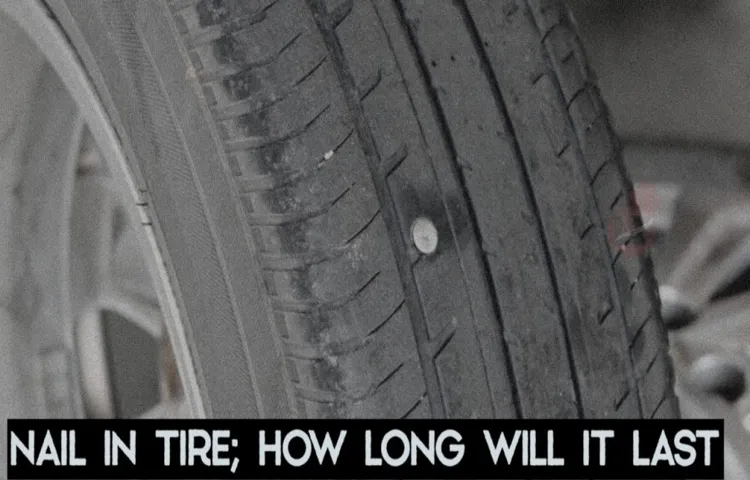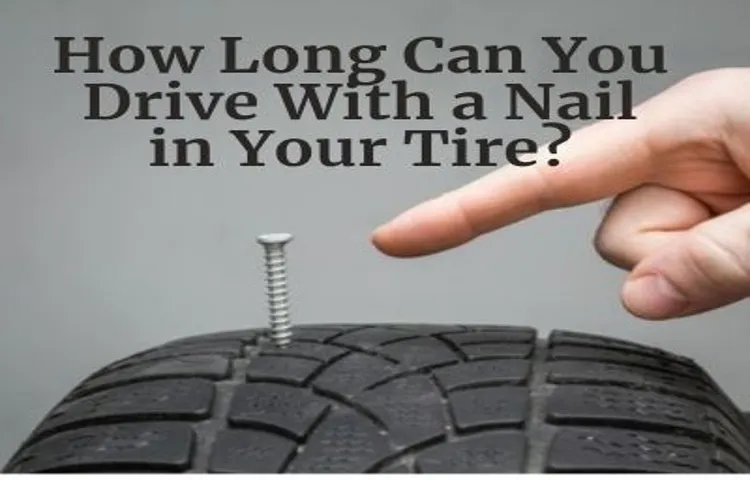Have you ever found yourself in a situation where you come out to your car just to find that one of your tires has a nail in it? It can be a frustrating experience, especially when you’re not sure how long the tire might last. You might be wondering, can a tire still be okay with a nail in it? How long can it last before it needs to be replaced? Well, the answer is not as straightforward as you might think. It really depends on a few different factors, such as where the nail is located and how quickly you address the issue.
But don’t worry, we’re here to break it down for you. So sit tight and let’s dive into the world of tire repair!
Table of Contents
Factors Affecting Tire Life
When a tire gets punctured by a nail, it can be frustrating and worrisome. Not only can it be an inconvenience, but it can also impact the longevity of the tire. A tire punctured by a nail can potentially last for weeks or months, depending on various factors.
The most significant factor is the placement of the nail. If the nail is located on the tread area and punctures a larger hole, then it can cause a significant loss of air pressure, which can result in the tire being unable to support the vehicle’s weight. Other factors that can affect the lifespan of a nail-punctured tire include the tire’s age, condition, and quality, as well as how quickly the puncture was identified and repaired.
While it may be tempting to continue driving on a nail-punctured tire, it is important to address the issue as soon as possible to prevent further damage and ensure the safety of the vehicle’s occupants.
Size and Location of the Nail
When it comes to tire life, there are a variety of factors that can impact how long your tires last. One of the most important factors to consider is the size and location of any nails or other debris that may puncture your tires. Smaller nails or screws may not cause immediate damage but can slowly lead to a leak over time.
Additionally, the location of the nail – whether it’s near the center of the tire or closer to the edges – can impact the level of damage. Nails near the sidewall of the tire can cause more severe damage and often require the tire to be replaced. That’s why it’s important to regularly inspect your tires for any signs of damage or punctures, regardless of size or location.
By doing so, you can catch any potential issues early on and prevent further damage from occurring. So, take a few minutes to give your tires a quick once-over – it could end up saving you time and money down the road!

Type of Tire
When it comes to tire life, the type of tire you choose is a critical factor. In general, there are three types of tire: summer, winter, and all-season. Summer tires are designed for warm temperatures and dry road conditions, while winter tires are made for colder climates and snowy or icy road surfaces.
All-season tires are a combination of both, and can be used year-round in moderate climates. Each type of tire is specifically designed for a particular purpose, and using the wrong type of tire for your driving conditions can significantly affect the lifespan of your tires. For example, using summer tires in cold temperatures can cause them to crack and deteriorate more quickly.
On the other hand, using winter tires in hot temperatures can cause them to wear out faster and decrease their effectiveness. Choosing the right type of tire for your climate and driving conditions can help to extend the life of your tires and keep you safer on the road.
Driving Habits and Road Conditions
When it comes to tire life, a lot can depend on factors outside of the actual tire itself. Your driving habits and the road conditions you encounter can greatly affect how long your tires last. For example, if you tend to brake hard frequently, your tires will experience more wear and tear.
Similarly, if you frequently drive on rough roads, your tires will wear down more quickly. On the other hand, if you drive smoothly and avoid sudden stops, your tires will last longer. In addition, proper tire inflation and regular rotations can also help extend the life of your tires.
Ultimately, it’s important to take care of your tires and be mindful of how you drive and the roads you travel on to ensure that you get the most out of your investment.
What to Do with a Nail in Your Tire
If you find a nail in your tire, the first thing you should do is assess the damage. If the nail is in the tread, it might be possible to have the tire repaired. However, if the puncture is on the sidewall or in the shoulder of the tire, you will likely need to replace the tire altogether.
As for how long a tire can last with a nail in it, that really depends on the severity of the puncture and how quickly you can address the issue. If you ignore the nail and continue to drive on the tire, the damage will only get worse and could eventually lead to a blowout. It’s always best to have a professional take a look at the tire as soon as possible to assess the damage and determine the best course of action.
While it may be tempting to try and save some money by driving on a punctured tire, the safety risks are simply not worth it. So, if you find yourself in this situation, don’t take any chances and seek professional assistance immediately!
Remove the Nail
If you discover a nail in your tire, you may be filled with dread and confusion. What should you do? First things first, don’t panic. Removing the nail yourself is not recommended unless you have experience as it can cause further damage to the tire.
Instead, take your vehicle to a reputable mechanic or tire shop to have it inspected and repaired. Driving on a tire with a nail can cause a slow leak or even a blowout if left unattended. It’s best to address the situation as soon as possible to prevent any further issues.
A trained professional can assess the damage and determine the best course of action, whether it be a simple patch or replacement of the tire. Remember, the safety of you and your passengers is top priority, so take your vehicle in for a proper check-up as soon as possible.
Assess the Damage
If you find a nail in your tire, the first thing you need to do is assess the damage. Is the tire visibly flat or losing air pressure? If yes, then you need to take immediate action to fix or replace the tire. But if the nail hasn’t pierced the tire deeply, then it is possible that the tire can still be repaired.
However, it’s important to note that even a small puncture can cause significant damage to the tire, and over time, the tire could become unsafe to drive on. Therefore, you should take the tire to a professional mechanic as soon as possible to determine the best course of action. They will be able to assess the depth and location of the puncture and make recommendations on whether or not the tire can be repaired and how to prevent further damage or potential blowouts on the road.
Remember, being proactive and addressing the issue promptly can help you avoid costly repairs down the line, so don’t wait to take action if you suspect your tire has been damaged by a nail.
Repair or Replace the Tire
Finding a nail in your tire can be a frustrating experience, but it’s important to know what to do next. In some cases, the nail may be lodged in the tread and not causing any significant damage to the tire. If this is the case, the nail may be able to be removed and the tire can be repaired by a professional.
However, if the nail has caused a puncture in the sidewall or the tire is showing signs of wear and tear, it may be time to replace the tire altogether. It’s important not to ignore a nail in your tire, as it can lead to further damage and potentially dangerous situations on the road. Make sure to inspect your tires regularly for any signs of damage, and if you do find a nail embedded in your tire, take action promptly to ensure your safety on the road.
Remember, it’s always better to be safe than sorry, so don’t hesitate to speak to a professional if you’re unsure about what to do next.
Conclusion: When to Replace a Tire with a Nail in It
In the age-old question of how long can a tire last with a nail in it, we can confidently say that it depends on a multitude of factors like the size and location of the puncture, the type and age of the tire, and the speed and distance it is driven. But ultimately, there is no hard and fast rule for the lifespan of a tire with a nail in it – it’s like trying to predict how long a relationship can last with a little thorn between two loving souls. So, just like in love, prevention is the key – regular maintenance and inspections can save your tires from the treacherous nails on the road and keep them rolling for many happy miles.
After all, isn’t prevention better than the sorry sight of a flat tire on a rainy night?
FAQs
Can a tire be repaired if it has a nail in it?
Yes, a tire can be repaired if the puncture is in the tread and not on the sidewall. However, it is important to have a professional determine if the nail has caused any structural damage to the tire before repairing it.
How long can a tire last with a nail in it?
It depends on the size and location of the nail, as well as the type of tire. In general, it is not safe to drive on a tire with a nail, so it is recommended to get it repaired or replaced as soon as possible.
What are the risks of driving with a nail in a tire?
Driving with a nail in a tire can lead to a slow leak, which can cause the tire to lose pressure and become unsafe to drive on. It can also cause the tire to blow out, particularly at high speeds or on hot roads.
Can a tire with a nail in it still be balanced?
Yes, a tire with a nail in it can still be balanced if it is repaired properly. However, if the nail has caused any damage to the tire, it may need to be replaced instead of repaired.
How much does it cost to repair a tire with a nail in it?
The cost of repairing a tire with a nail in it can vary depending on the location of the nail and the type of tire. In general, it can cost anywhere from $20 to $50 to repair a punctured tire.
How can I prevent a nail from puncturing my tire?
You can prevent nails from puncturing your tire by avoiding driving in hazardous areas such as construction sites or areas with a lot of debris. You can also make sure your tires are properly inflated and have adequate tread depth.
What should I do if my tire blows out due to a nail puncture?
If your tire blows out due to a nail puncture, you should pull over to a safe location and change the tire. It is important to have a spare tire in your car and be familiar with how to change a tire.



